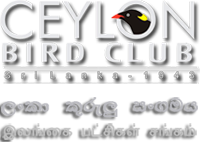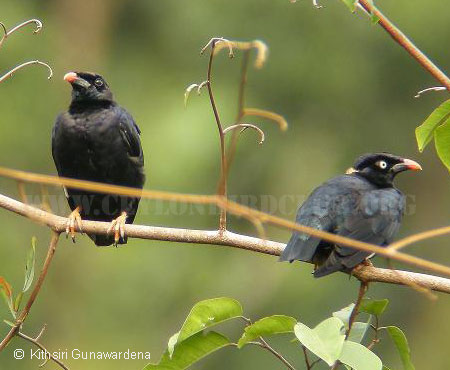


Ceylon Hill Mynah Gracula ptilogenys
Sinhalese - Selalihiniya

The Ceylon Hill Mynah is distinguished from the Common Hill Mynah by its somewhat larger size, in having only two small wattles on the nape and black at the base of the orange-red beak. Its black plumage has a more purple sheen. The sexes are alike except in iris colour. Evidence seems to point that it is the male bird’s iris that is brown while that of the female is white.
This is a bird of wet zone and wet hill forests, found up to 2000 metres elevation. It generally lives in pairs or small flocks though sometimes larger gatherings are encountered close to fruiting trees. It is a bird of high canopy where it moves about restlessly uttering loud, drawn out whistling calls. A frequently uttered call is a loud h’yoch. While flying the wings produce a rather musical hum which is easily recognized when once heard. It also utters other short, harsh guttural calls. Overall, its calls are more ‘throaty’ than those of the Common Hill Mynah. The bird appears to move much in a day’s wanderings, but its presence is always advertised by its loud calls. The bird is a fruit eater, wild fig and the fruit of the ‘ Sapu’ Michelia champaca tree being favourites.
Nesting takes place in the early part of the year with a possible second season in August- September. The bird nests in tree holes, either natural or disused nests of woodpeckers. These are generally around eight metres from ground level or higher, located within forest or on its outskirts. Both adults have been observed to bring material to the nest hole. First twigs are added followed by finer material which probably forms the lining. Both adults feed the young as well. Therefore it is possible that both incubate the eggs too. The eggs are two in number, pale blue in ground colour blotched with purplish-brown.